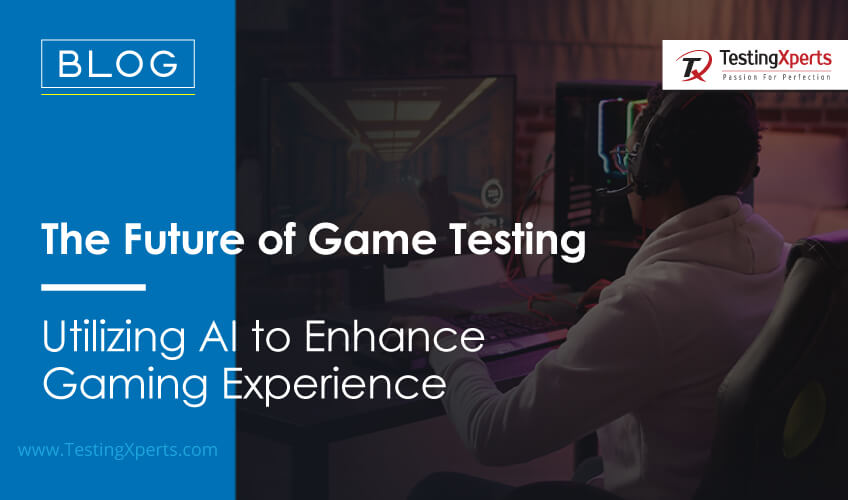
- What is Game Testing?
- Brief Overview of the Evolution of Game Testing
- List of Different Types of Game Testing
- The Role of Emotional Testing in Games
- Different Aspects of Emotional Testing
- Ensuring Accessibility and Inclusivity in Game Testing
- Strategies for Testing Games for Accessibility and Inclusivity
- Upcoming Advancements in Game Testing Technology
- Conclusion
- Why Choose TestingXperts as a Game Testing Service Provider?
What is Game Testing?
Game testing involves evaluating video games to identify and resolve bugs, glitches, and other issues that may impact the gameplay experience. It involves systematically playing the game, executing various actions, and examining its different elements to ensure that it functions as intended and provides players with an enjoyable and immersive experience.
The primary goal of game testing is to identify and report any issues or defects that may affect gameplay, graphics, audio, user interface, or other aspects of the game. Testers document their findings, providing detailed bug reports with steps to reproduce the issues, screenshots, and videos for developers to review and address.
Different Types of Bugs in Game Testing
- Functional Bugs:
These bugs affect the core functionality of the game. They can involve issues with game mechanics, controls, character interactions, or gameplay features. For example, a functional bug may cause a character to move incorrectly, a button to become unresponsive, or a quest not to progress as intended.
- Audio Bugs:
These bugs affect the game’s sound and cause music issues. They can include missing or distorted audio, incorrect sound effects, or synchronization problems. For instance, dialogue lines may not play or overlap, or specific sound effects may not trigger when expected.
- Collision Bugs:
These bugs occur when objects or characters within the game interact improperly with each other or the environment. These bugs can lead to characters getting stuck in walls, things passing through solid surfaces, or incorrect physics interactions
- Performance Bugs:
They impact the game’s performance and optimization. Performance bugs can cause low frame rates, long loading times, excessive memory usage, or sudden crashes. These bugs can degrade the gaming experience and make the game unplayable or frustrating for players.
Game testing software like Unity Test Tools, GameAnalytics, etc., are valuable tools for game developers and testers to address the above-mentioned bugs. They provide a streamlined and efficient way to manage testing efforts.
With features like test case management, bug tracking, test execution automation, collaboration tools, and insightful reporting, game testing software simplifies the testing process, enhances communication, and improves overall efficiency. By utilizing these tools, developers can identify and resolve issues more effectively, leading to higher-quality games and an improved player experience.
Game testing is often mistakenly seen as simply searching for bugs and glitches in video games in the United Kingdom (UK). However, it is much more than that. Game testing plays a vital role in ensuring the overall quality, performance, and user experience of a game. It involves a comprehensive evaluation of various aspects, including gameplay mechanics, level design, graphics, audio, controls, and overall balance.
In this blog post, we will delve into the multifaceted nature of game testing in the UK, highlighting its significance and the various dimensions it encompasses beyond mere bug hunting.
Brief Overview of the Evolution of Game Testing

The evolution of game testing can be traced back to the early days of video games when the testing was primarily done manually by the developers themselves. As the video game industry grew, testing became a specialized field with the rise of game testing companies in the 1990s. During this period, the primary focus was game functionality testing and finding compatibility issues. With the introduction of online gaming, game testing became more complex and shifted towards network and security testing.
The mobile gaming boom in the 2000s led to a new set of challenges for the video game tester, such as compatibility with various devices and app stores. Today, mobile game testing has evolved to include emotional testing, user experience testing, and accessibility testing. The rise of virtual reality and augmented reality has also presented new challenges for game testers, including motion sickness and latency issues. As the gaming industry continues to evolve, automated gaming testing services will remain a critical aspect of game development to ensure that games meet user expectations and deliver an optimal gaming experience.
List of Different Types of Game Testing
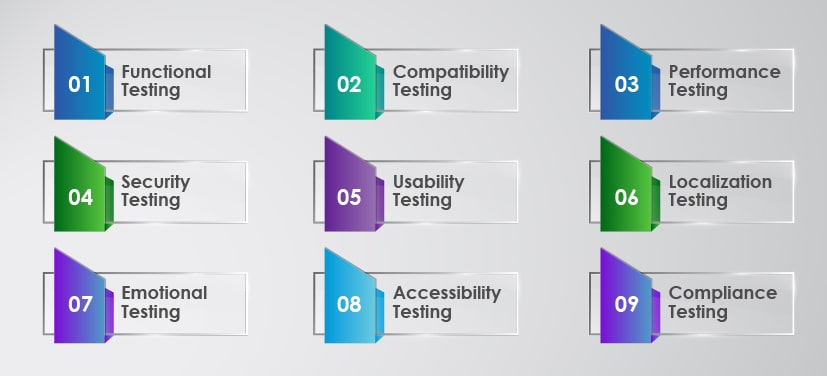
Game testing involves evaluating the quality, functionality, and user experience of a game. There are different types of game testing techniques, each with its own specific focus and goals. Here are some of the main game testing types:
Functional Testing:
This type of testing ensures that the game functions as intended, with all features and functions working as they are intended to.
Compatibility Testing:
Game compatibility testing involves evaluating the game’s compatibility with different platforms, devices, and software versions.
Beta Testing:
Beta testing is a crucial phase in game development that allows developers to gather valuable feedback from a diverse group of players before the game’s official release. By conducting beta testing, developers can identify and fix bugs, assess gameplay balance, and gain insights into player preferences.
Performance Testing:
Gaming performance testing measures the game’s speed, responsiveness, and stability under various conditions.
Security Testing:
This type of testing evaluates the game’s ability to protect against unauthorized access, cheating, hacking, and other security threats.
Usability Testing:
This type of testing focuses on the game’s ease of use, including navigation, controls, and overall user experience.
Localization Testing:
This type of testing ensures that the game is culturally appropriate and adapted for different regions and languages.
Emotional Testing:
This type of testing evaluates the emotional response of players to a game, measuring factors such as engagement, satisfaction, and likelihood of recommending the game to others.
Accessibility Testing:
This type of testing ensures that the game is accessible to players with disabilities, including visual, auditory, and motor impairments.
Compliance Testing:
This type of testing ensures that the game adheres to legal and regulatory requirements, such as age ratings and content restrictions.
By conducting various types of game testing, developers can ensure that their games meet high standards for quality, functionality, and user experience.
Game Testing Phases
As a game developer, you understand the critical role that testing plays in delivering a smooth and immersive gaming experience to your players. Testing is not just a one-time event but a systematic process that spans multiple game testing phases to ensure the quality and functionality of your game:
- Phase 1: Planning and Preparation:
Every successful game-testing effort begins with careful planning and preparation. During this phase, you define your testing objectives, create plans, and identify the required resources and tools. It is crucial to establish clear testing goals, prioritize features to be tested, and determine the target platforms and hardware configurations. - Phase 2: Testing Functionality:
It verifies that the game functions as intended. Testers meticulously examine all gameplay elements, including controls, menus, levels, and character interactions. They confirm that the game mechanics, such as physics, AI, and collision detection, operate correctly. Bugs and issues discovered during this phase are documented, categorized, and prioritized for resolution. - Phase 3: Testing Performance:
Testers assess your game’s performance under various conditions in this phase. Testers evaluate the game’s frame rate, load times, memory usage, and responsiveness. They conduct stress testing to simulate high player loads and identify performance bottlenecks or stability issues. This phase ensures your game runs smoothly and delivers an optimal experience across different platforms and hardware configurations - Phase 4: Compatibility Testing:
It is a crucial game testing method that ensures your game works seamlessly across multiple platforms, operating systems, and hardware devices. Testers meticulously test your game on various devices, screen resolutions, and aspect ratios, verifying that it adapts well to different configurations without graphical glitches or functional errors. This phase is particularly crucial for mobile and console game development. - Phase 5: Localization Testing:
It involves assessing your game’s readiness for international markets. Testers verify the accuracy of translated texts, ensure that localized assets display correctly, and validate cultural appropriateness. They check for language-specific issues, such as text overflow or character encoding problems, to ensure that players worldwide can enjoy your game without hindrance. - Phase 6: User Acceptance Testing:
This involves engaging real players to evaluate your game’s overall user experience. Testers gather feedback on gameplay, difficulty levels, intuitiveness, and any potential areas for improvement. UAT provides valuable insights into how your game resonates with its target audience and helps identify any last-minute issues before release. - Phase 7: Regression Testing:
It ensures that fixes and updates do not introduce new bugs or regressions into previously tested features. Testers retest the once problematic areas to ensure that the fixes have been implemented successfully and that the game still functions as intended. - Phase 8: Post-Release Support:
Game testing doesn’t end with the game’s release. Testers continue to monitor and address issues reported by players, providing prompt bug fixes and updates. This ongoing support helps maintain the game’s reputation and player satisfaction, ensuring a positive gaming experience even after launch.
The Role of Emotional Testing in Games
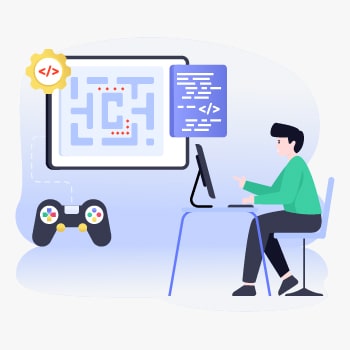
Emotional testing is an essential aspect of game testing that evaluates the emotional responses of players to a game. Emotional testing involves measuring how a game makes players feel, their level of engagement, and how likely they are to recommend the game to others. This type of testing allows game developers to understand how players react to different aspects of the game, such as the storyline, characters, and game mechanics.
Emotional testing can help developers identify what elements of the game are most appealing to players and what needs improvement. By testing emotional responses, developers can ensure that players are fully engaged with the game, leading to better retention rates and increased revenue. In addition, emotional testing can help create more immersive and memorable game experiences. Overall, emotional testing is an essential tool for game developers to create games that not only function well but also deliver an emotional impact on players.
Different Aspects of Emotional Testing
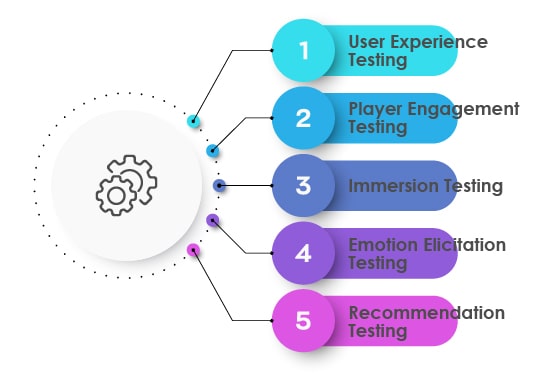
Emotional testing includes various aspects that help measure the overall user experience and player engagement. Here are some of the key aspects of emotional testing:
User Experience Testing:
This type of testing measures the overall user experience of the game, including the ease of use, navigation, and overall enjoyment of the game.
Player Engagement Testing:
This type of testing measures the level of player engagement with the game, including how long players spend playing the game and how often they return to play again.
Immersion Testing:
This type of testing evaluates the game’s ability to create an immersive experience for players, including how well the game’s story, characters, and world-building engage players.
Emotion Elicitation Testing:
This type of testing measures the game’s ability to evoke different emotions in players, such as excitement, joy, and suspense.
Recommendation Testing:
This type of testing measures the likelihood that players would recommend the game to others, based on their emotional response to the game. By conducting emotional testing in these different aspects, game developers can gain insights into how players perceive their game, give attention to detail, and identify improvement areas. Emotional testing helps ensure that games not only function well but also provide an engaging and emotionally impactful experience for players.
Ensuring Accessibility and Inclusivity in Game Testing
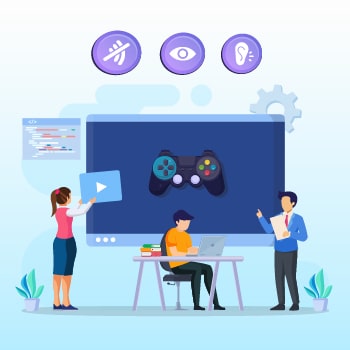
Ensuring accessibility and inclusivity in game testing is an essential aspect of game development. Accessibility testing involves evaluating the game’s ability to accommodate players with disabilities, including visual, auditory, and motor impairments. Inclusivity testing involves evaluating the game’s ability to appeal to a diverse range of players, including those from different cultures, genders, and backgrounds.
To ensure accessibility in game testing, developers should consider factors such as color contrast, font size, and the use of audio cues. Game developers can also implement features such as adjustable difficulty settings, subtitles, and alternative input methods such as voice recognition or eye-tracking technology.
Strategies for Testing Games for Accessibility and Inclusivity
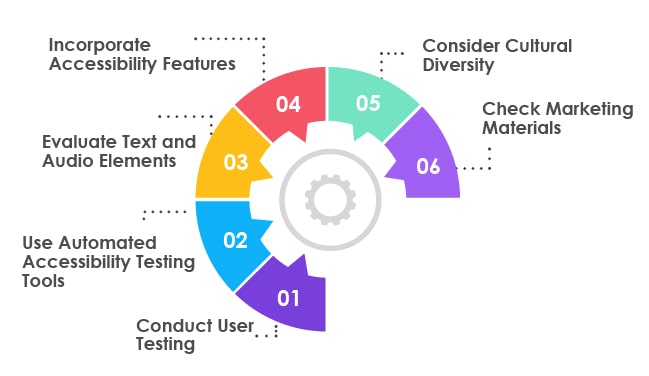
Testing games for accessibility and inclusivity requires specific strategies to ensure that all players can enjoy the game, regardless of their abilities or backgrounds. Here are some strategies that game developers can use to test games for accessibility and inclusivity:
Conduct User Testing:
To ensure accessibility and inclusivity, developers should conduct user testing with a diverse range of players, including those with disabilities and players from different backgrounds. This allows developers to gain insights into how players with different needs interact with the game and identify any issues that need to be addressed.
Use Automated Accessibility Testing Tools:
There are various game testing automation tools available for accessibility testing that can help developers identify accessibility issues in their game, such as color contrast, keyboard accessibility, and audio description.
Evaluate Text and Audio Elements:
Developers should ensure that all text and audio elements in the game are easily readable and audible, including captions, subtitles, and audio descriptions.
Incorporate Accessibility Features:
Developers should incorporate accessibility features into the game, such as adjustable difficulty settings, alternative input methods, and color-blind mode.
Consider Cultural Diversity:
Developers should ensure that the game’s storylines and characters are culturally appropriate and appealing to a diverse range of players.
The future of game testing is evolving rapidly, driven by advancements in technology and changing consumer expectations. According to a report by MarketsandMarkets, the global game testing market size is expected to grow from $5.5 billion in 2020 to $9.2 billion by 2025, at a compound annual growth rate (CAGR) of 10.8%. This growth is being driven by the increasing adoption of cloud-based game testing and the rising demand for game testing across multiple platforms, including game consoles, PCs, and mobile devices.
One of the key trends in the future of game testing in the United Kingdom is the integration of artificial intelligence (AI) and machine learning (ML) technologies. These technologies enable game developers to automate testing processes, identify and fix bugs more quickly, and improve the overall quality of the game. According to a report by ResearchAndMarkets, the global AI in gaming market size is expected to grow from $336 million in 2020 to $4.5 billion by 2027, at a CAGR of 40.5%.
Another trend in the future of game testing is the increasing importance of player feedback and community engagement. Game developers are increasingly turning to online communities and social media platforms to gather feedback from players and incorporate their suggestions into game development. This approach helps improve the game’s quality control and fosters a stronger connection between players and game developers.
Upcoming Advancements in Game Testing Technology
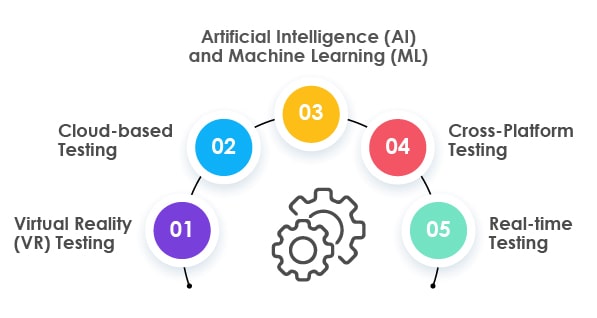
Advancements in technology are transforming the field of game testing, enabling developers to improve the quality and efficiency of their testing processes. Here are some of the upcoming advancements in game testing technology:
Virtual Reality (VR) Testing:
VR is becoming increasingly popular in the gaming industry, and as such, there is a growing need for effective testing of VR games. VR testing can help identify issues such as motion sickness and ensure that the game provides a comfortable and enjoyable experience for players.
Cloud-based Testing:
Cloud-based game testing enables developers to test games across multiple platforms simultaneously, without the need for physical hardware. This can help reduce costs and improve testing efficiency, as developers can access a wide range of devices and platforms remotely.
Artificial Intelligence (AI) and Machine Learning (ML):
AI and ML are increasingly being used in game testing to automate testing processes, identify bugs, and provide insights into player behavior. This can help reduce testing time and improve the overall quality of the game.
Cross-Platform Testing:
Cross-platform testing enables developers to test games across multiple platforms, including consoles, PCs, and mobile devices. This can help ensure that the game provides a consistent and enjoyable experience for players, regardless of the platform they are using.
Real-time Testing:
Real-time testing allows developers to test games as they are being developed, enabling them to identify and fix issues more quickly. This approach can help reduce development time and improve the overall quality of the games.
These advancements in game testing technology are set to revolutionize the way games are tested, making the game testing process more efficient, effective, and cost-effective.
Conclusion
Game testing is much more than just bug hunting for video game companies. The evolution of game testing has led to the emergence of various types of testing, including functional, non-functional, and emotional testing, all of which are critical for ensuring that games are of high quality and provide an engaging and enjoyable experience for players. Moreover, with the increasing demand for accessibility and inclusivity in games, testing for these aspects has become crucial for ensuring that games are accessible to a wide range of players, including those with disabilities.
As the gaming industry continues to grow, evolve, and launch various types of games, game testing will remain a vital aspect of video game development. The future of game testing looks promising, with advancements in technology such as AI, VR game testing, and cloud-based game testing, and the increasing importance of player feedback, community engagement, and game testing tools.
In essence, game testing is a collaborative effort involving game developers, quality assurance testers, and players working together to create the best possible gaming experience. By prioritizing quality and inclusivity in game testing, we can ensure that games are not just entertaining, but also accessible and engaging for all players.
Why Choose TestingXperts as a Game Testing Service Provider?
• Our team Comprises highly skilled and passionate game testers with extensive industry experience. They understand the depth of game development and are equipped to identify and report even the most subtle issues.
• We employ a rigorous automated video game testing approach that covers all aspects, including game functional testing, game localization testing services, usability, compatibility, game performance testing, and more. Our comprehensive game qa testing service ensures that your game is ready for launch on multiple platforms and meets the expectations of players worldwide.
• We use the latest tools and technologies to streamline our testing processes and deliver accurate results efficiently. Our advanced automated video game testing infrastructure lets us quickly uncover bugs and performance issues, saving our clients time and resources
• We offer customized games testing solutions tailored to your specific needs. Whether you need compatibility testing for a new platform, localization testing for different regions, or multiplayer stress testing, we can adapt our services accordingly.
• With our agile testing methodologies and penetration testing for games, we ensure quick turnaround times without compromising on quality. We aim to help you meet your deadlines and maintain your competitive edge.
• Quality is at the core of everything we do. We are committed to delivering exceptional testing services beyond identifying issues. Our team provides valuable feedback and suggestions for improvement, helping you enhance the overall gameplay experience and increase player satisfaction.
You gain a competitive advantage by choosing TestingXperts, a leading game testing company for your game QA testing service needs. Our expertise, comprehensive approach, cutting-edge tools, customized solutions, speed, efficiency, detailed reporting, and commitment to quality set us apart from competitors. We strive to be your trusted partner in ensuring your games are polished, bug-free, and ready to captivate players worldwide.
Looking forward to getting advanced game testing services in the UK? As one of the leading game QA companies, TestingXperts specialize in providing comprehensive and high-quality game testing services that ensure your games are flawless and deliver an outstanding player experience. Get in touch with our game testing experts and we will take it from there.
Discover more
Get in Touch
Stay Updated
Subscribe for more info


